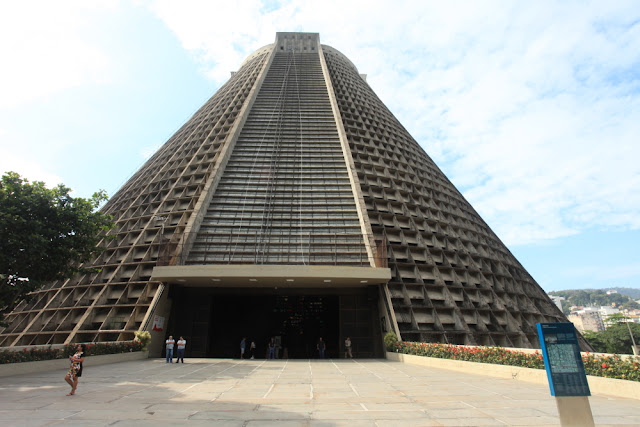Crossing the great Amazon River about 200 miles west of Manaus, Brazil.
A large southern tributary of the Amazon. These rivers are huge!
Closer to Rio, we saw towering cloud formations. The photo does not do justice for the scale of these teeming columns of water vapor.
Avenues of clouds and thunderstorms. It was amazing.
Looking across the northern suburbs of Rio de Janeiro toward the Tijuca Forest (mountain in the upper right) and the sentinel of the Paõ de Açucar or Sugarloaf Mountain in the distance on the left.
Coming in to the landing with downtown Rio and the Sugarloaf visible.
Rio is a city of tunnels, built to ease traffic through the granite mountains.
The train station at Corcovado in the Cosme Velho neighborhood. This cog railway train brings people top the top of Corcovado Mountain at 2,300 feet, where the Christ the Redeemer statue is located.
Sycamore tree trunk and street art across from the train station. Rio is rife with graffiti and street art. It is everywhere. Note the obscure graffiti to the left of the tree - most of the street art is o this type.
The Christ the Redeemer statue is one of the biggest draws in the city. In 2011 it was voted as one the New Seven Manmade Wonders of the World.
The view from the statue platform looking toward the Lagoa de Freitas and Ipanema Beach.
View from the Sugarloaf Mountain to Corcovado Mountain. A fog enveloped the Sugarloaf in the afternoon but this view appeared for five seconds. Otherwise it was gray fog the whole time.
On this trip I visited places in downtown Rio that I had never stopped at before.
This is the Saõ Sebastiaõ Cathedral (or Metropolitan Cathedral) and I had never before stopped here. From the outside it looks like a Mayan temple and is said that 20,000 people can stand inside of it.
The light coming through he stained glass panels was an exceptional sight.
Beautiful!
The modern skyline of Rio de Janeiro is perhaps an unknown aspect of the city, compared to its more famous beach scenes.
This is the landing for the original port in Rio. You can see the stairways that led down to the water, now located about 100 meters behind the photograph.
Carmen Miranda is a legend in Rio and I never knew anything about her until I read this.
There is a lot of work to be done to rehabilitate the original commercial district in Rio but the "bones" for future work are tere.
More street graffiti. This type of art tends to diminish the overall beauty of the city (and I only take pictures of the most striking forms - most of it is just black or white alphabetical gibberish) and the city fathers are trying to encourage street artists to up the quality of the art rather than stop it entirely.
However, the port section of town has been totally revitalized because of the 2014 World Cup and 2016 Olympic events.
This is the brand new Museo do Amanha (Museum of Tomorrow) and has a very interesting design.
#cidadeolimpica. See the short film here.
There is also a new light rail system in this part of the city. Rio has a fledgling subway system for its 6.5 million inhabitants.
We are now flying to Iguaçu Falls on the Argentinian border and saying goodbye to Rio. Here are a fews shots of the great views I had while leaving the city.
The entrance to Guanabara Bay with ships entering and leaving. The Paõ de Açucar guards the harbor entrance which was on the original list of the Seven Natural Wonders of the World. However, 70% of the city's sewage is now dumped into the bay untreated. What once was a tropical paradise has been been turned into a toxic soup. One hopes that in the future this can be rectified.
Much of the heart of Rio de Janeiro can be seen in this view. Note the tiny cloud on the far left drapping over the Paõ de Açucar and the small white dot of the Christ the Redeemer statue on the sharp peak just above the photo's center. Downtown Rio is where the tall buildings are seen on the far right center. The famous beaches of Copacabana and Ipanema face the South Atlantic Ocean at the far left.
Downtown with the new Museo do Amanha jutting out to the right within the bay.
Lastly, these are the two famous beaches in Rio - Copacabana Beach on the right and Ipanema on the left. We are now on our way to Iguaçu Falls!






























No comments:
Post a Comment
If your comment will not post, email me with the problem.